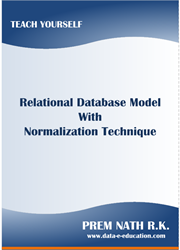

- Physical Data Storage Method
-
- Hierarchical Database Model
- Network Database Model
- Relational Database Model
- Object Database Model
- Object Relational Database Model
Hierarchical Database Model
In the Hierarchical Database Model, Data is organized into Upturned Tree Structure based on Parent and Child Data Relationships. A Parent Data File Entity can design with one or many Child Data File Entities. Each Child Data File Entity must have map with one Parent Data File Entity.
The Information can access from Parent Data into Child Data and independently, a Child Data cannot access. Hierarchical Database is supporting One-To-One and One-To-Many Relationships. This Model is suitable to design and develop Manufacturing Industry and Bank Transaction Management Application.
In 1968, IBM released Information Management System (IMS) Product. This is the first commercial Database Management System. This IMS Database organized a Standardized Data Records with another Standardized Data Records based on Hierarchical Database Model Concept. In 1973, this IMS is classified like a Hierarchical Database.
IBM focused "Automobile and Manufacturing Industries" to implement IMS Product in the Production Planning Application and maintain Bill of Material Information. However, IMS is widely used Database Management System on IBM Mainframes to manage high-volume transaction processing applications. An Instance, Bank ATM Transaction, Auditing Credit Card Numbers and etc.
IMS Physical Data Storage Structure is Simple. IMS is storing Parent and Child Relationships with Physical Pointers from one Data Record into another Data Record. This Pointer Concept is help to retrieve Data Records Quickly from high-volume Database. In the IMS, the Parent Data Records store in one Disk and the Child Data Records store in different Disk to minimize Disk Input and Output Process. IMS introduced different Data Security Mechanism and managed Data Redundancy, Data Inconsistency and Data Anomaly.
Hierarchical Database Model has some limitation that Hierarchical Database Model is supporting Binary Relationship with One-To-One or One-To-Many Connectivity and Cordiality Information. Ternary and Unary Relationship Information cannot design and implement from this Model. Hierarchical Database Model has Low Flexibility to design and develop a Complete Commerce Application and the Database Maintenance Cost is HIGH.
In the Hierarchical Database Model, Data is organized into Upturned Tree Structure based on Parent and Child Data Relationships. A Parent Data File Entity can design with one or many Child Data File Entities. Each Child Data File Entity must have map with one Parent Data File Entity.
The Information can access from Parent Data into Child Data and independently, a Child Data cannot access. Hierarchical Database is supporting One-To-One and One-To-Many Relationships. This Model is suitable to design and develop Manufacturing Industry and Bank Transaction Management Application.
In 1968, IBM released Information Management System (IMS) Product. This is the first commercial Database Management System. This IMS Database organized a Standardized Data Records with another Standardized Data Records based on Hierarchical Database Model Concept. In 1973, this IMS is classified like a Hierarchical Database.
IBM focused "Automobile and Manufacturing Industries" to implement IMS Product in the Production Planning Application and maintain Bill of Material Information. However, IMS is widely used Database Management System on IBM Mainframes to manage high-volume transaction processing applications. An Instance, Bank ATM Transaction, Auditing Credit Card Numbers and etc.
IMS Physical Data Storage Structure is Simple. IMS is storing Parent and Child Relationships with Physical Pointers from one Data Record into another Data Record. This Pointer Concept is help to retrieve Data Records Quickly from high-volume Database. In the IMS, the Parent Data Records store in one Disk and the Child Data Records store in different Disk to minimize Disk Input and Output Process. IMS introduced different Data Security Mechanism and managed Data Redundancy, Data Inconsistency and Data Anomaly.
Hierarchical Database Model has some limitation that Hierarchical Database Model is supporting Binary Relationship with One-To-One or One-To-Many Connectivity and Cordiality Information. Ternary and Unary Relationship Information cannot design and implement from this Model. Hierarchical Database Model has Low Flexibility to design and develop a Complete Commerce Application and the Database Maintenance Cost is HIGH.
|
|
|
Copyright © 2010 data-e-education.com. All rights reserved.
